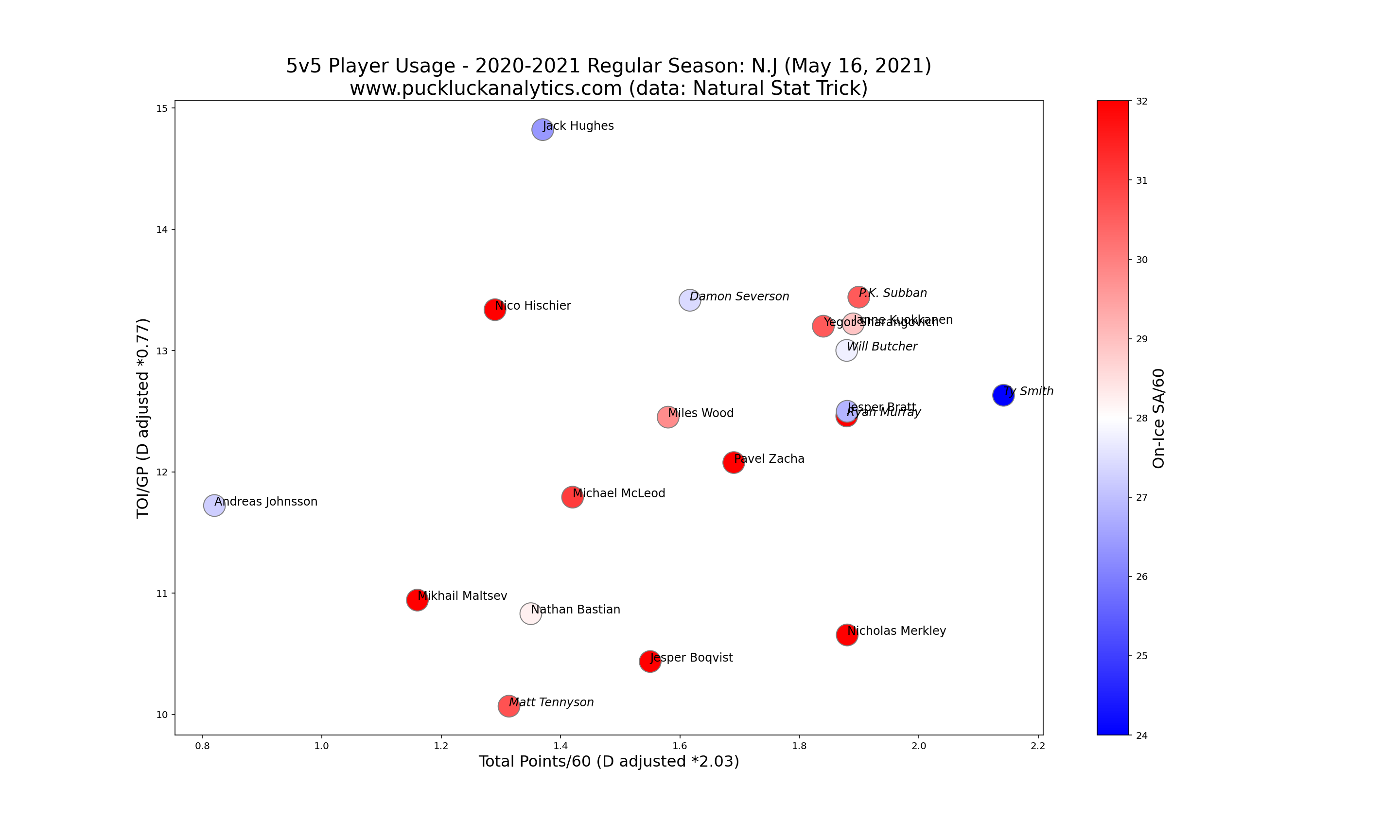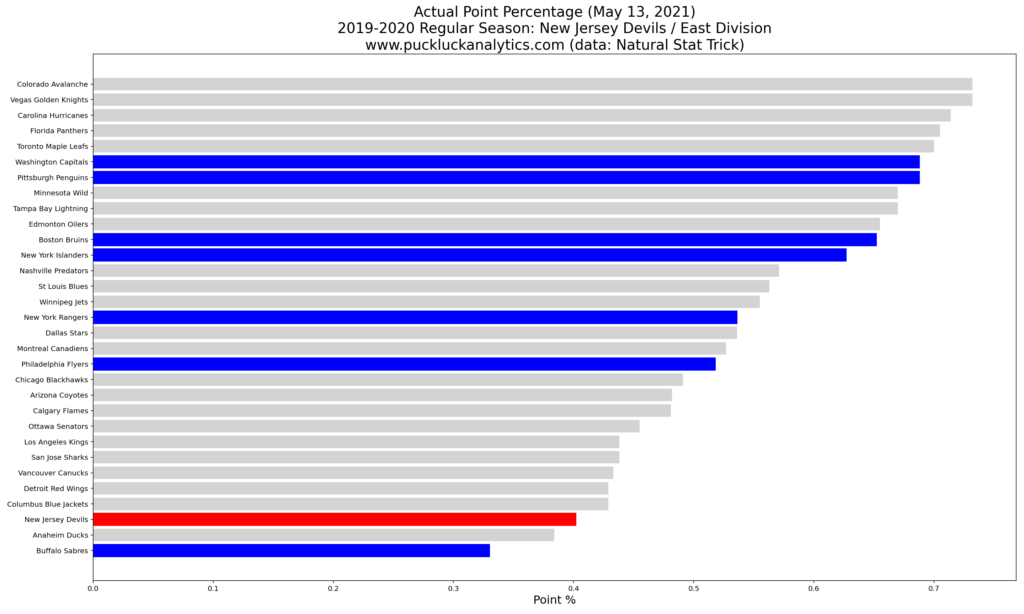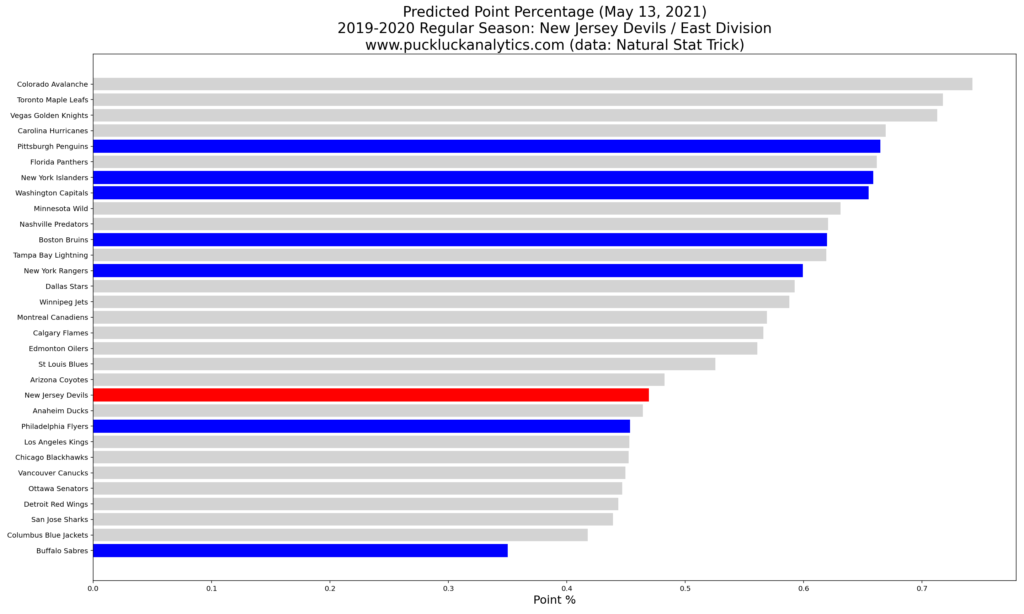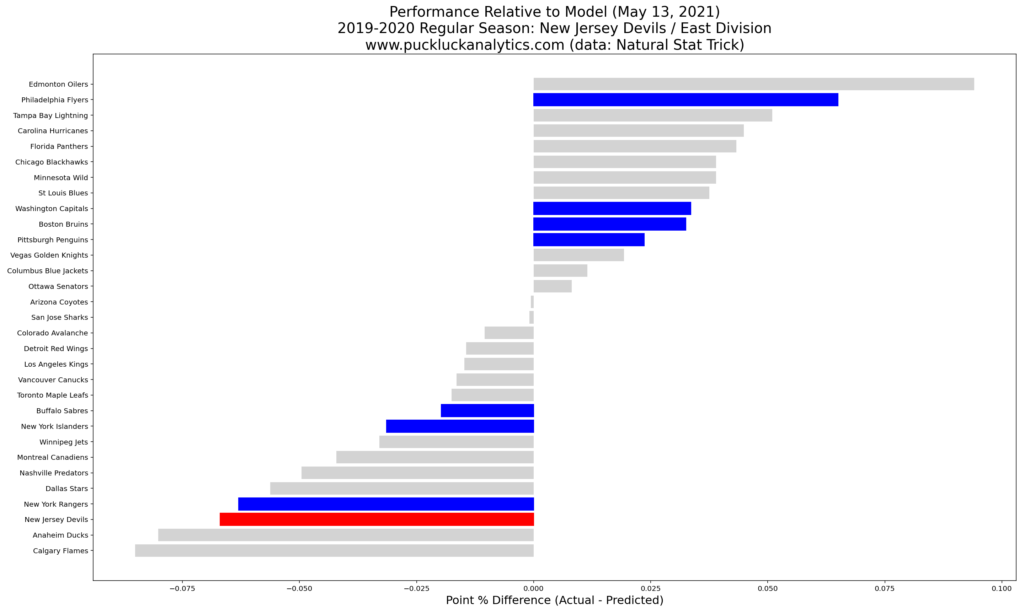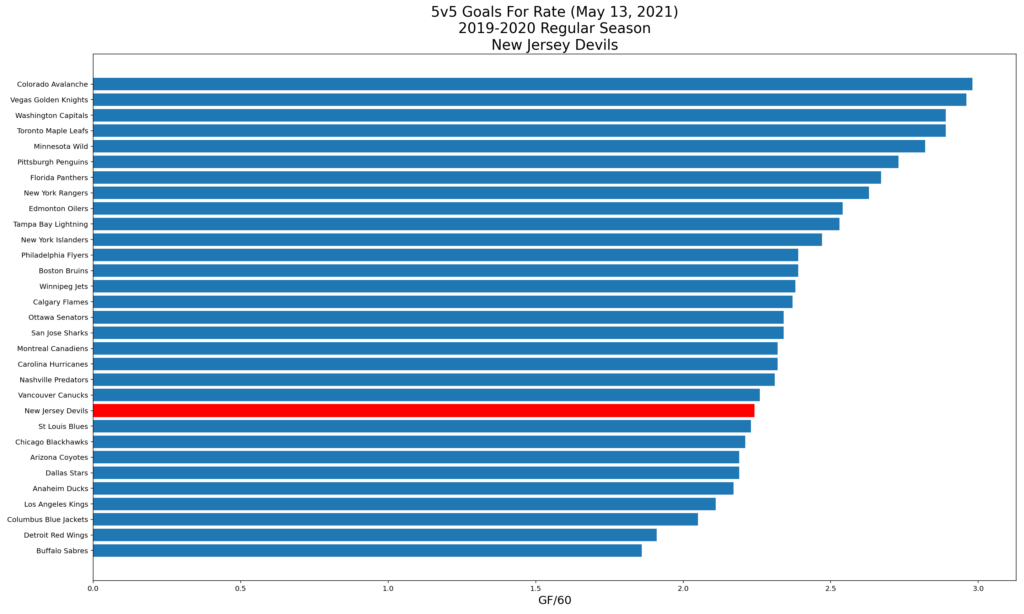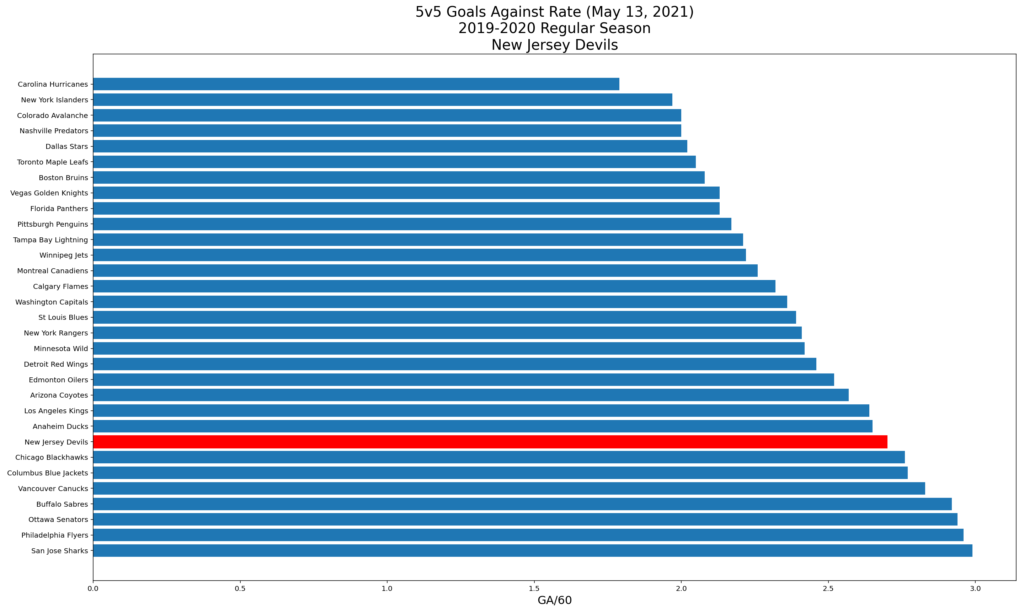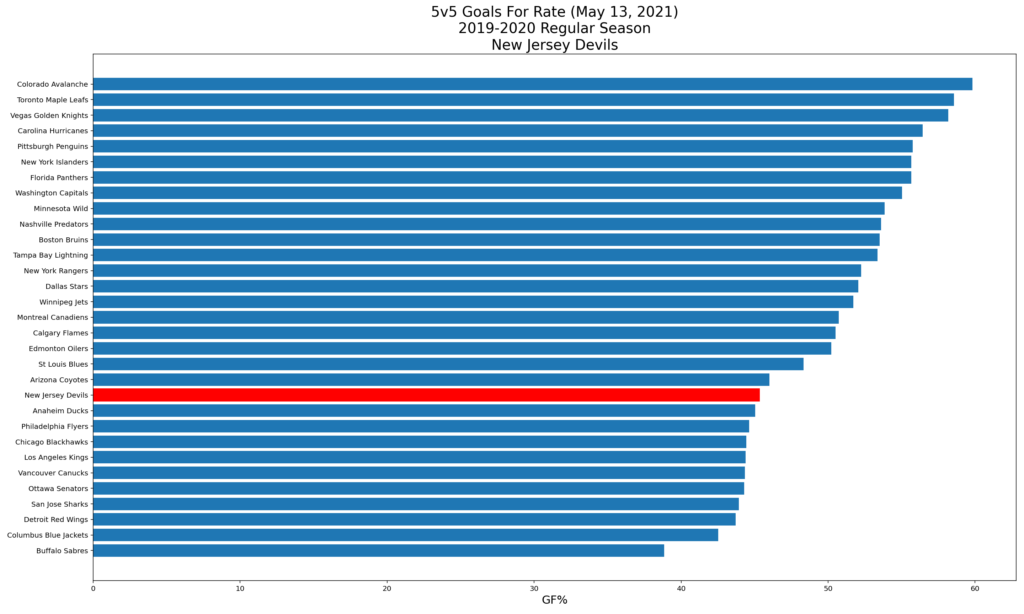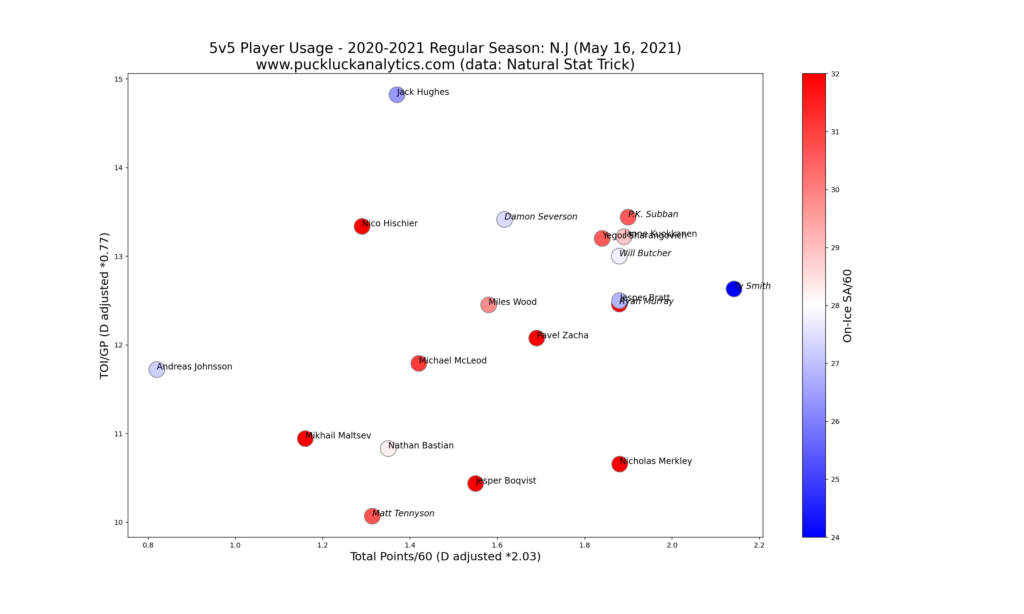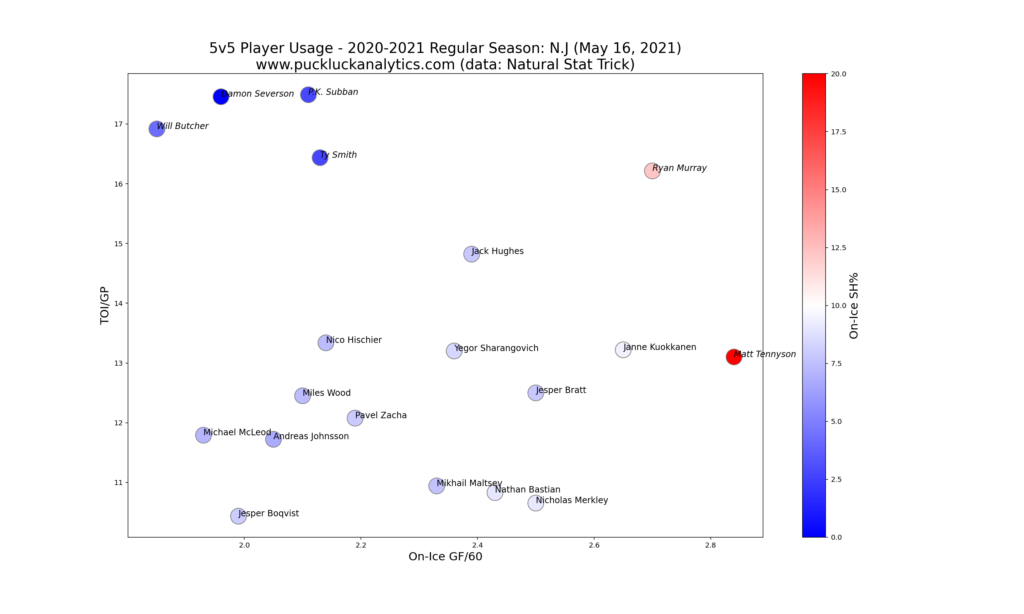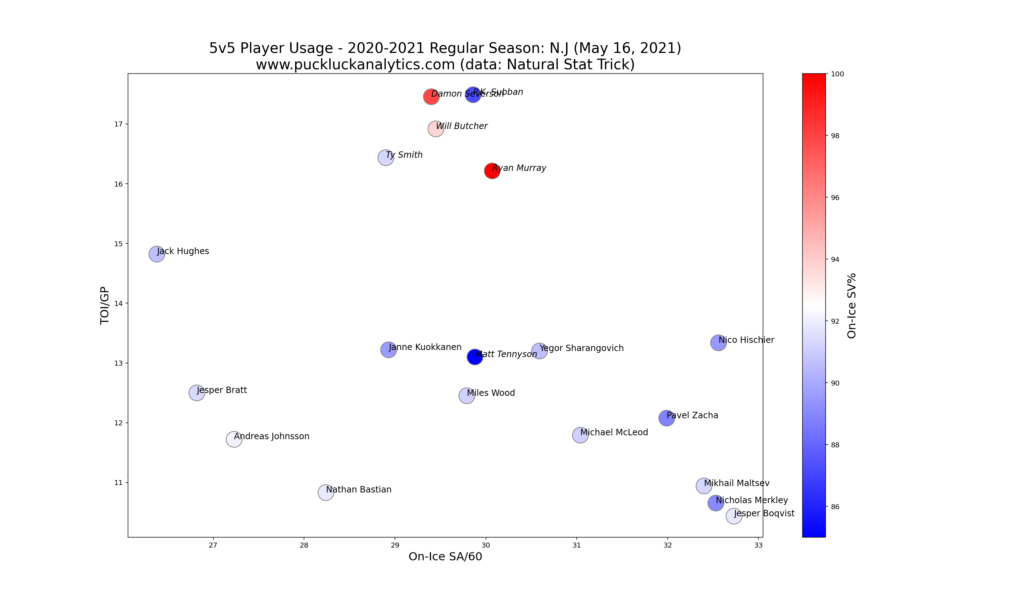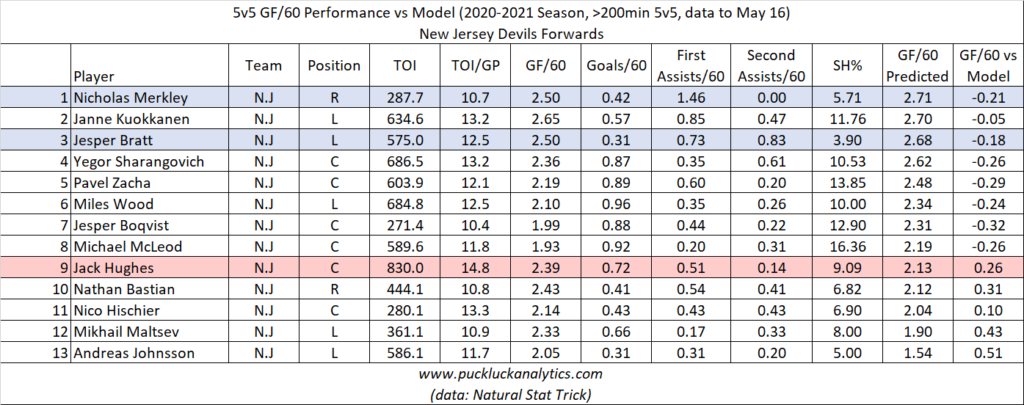The second stop in the East Division for my season reviews is New Jersey. For more detail on what I’m looking for in my review, check out this post.
While it was a tall task in the difficult East Division this season, The New Jersey Devils were expected by some to challenge for a playoff spot this season. In the end, they finished in 7th place in the division and are now looking to re-group heading into the 2021-2022 season.
Overall Performance
While the Devils 2020-2021 regular season didn’t provide much reason for optimism based on the final standings, we quickly find some looking at our points predictor model. The Devils actual point percentage relative to the model prediction was third worst in the league. Since we use only 5v5 data as input to the model, this indicates that the Devils had a stronger underlying game at even strength than initially meets the eye. In fact, the model puts the Devils ahead of the Philadelphia Flyers, one position higher in the division than the actual standings.
Let’s look at the inputs to the points predictor model for additional team level insight.
We see that the Devils’ 5v5 offensive and defensive performance was relatively balanced in comparison to the league. While both will need some improvement to get back into the playoff picture, they are closer than this year’s final standings suggest.
Player Performance
Let’s take a look at a player usage chart to get an overview of the Devils player’s individual performance this season. I’ve adjusted the defensemen points and ice time to allow direct comparison with the forwards. Ideally, we should see players plotted roughly on a diagonal from top right to bottom left, in a roughly organized depth chart.
We do see the diagonal distribution on the chart, suggesting that the Devils’ coaching staff utilized their players about as effectively as could be expected. Jack Hughes and Nico Hischier are outliers in this regard, appearing to be over-utilized based on their offensive point totals. This may be a case of young players with plenty of hype being thrust into the spotlight a bit too soon. We’ll keep an eye on this as we progress through our review.
Let’s move on to examining on-ice GF/60 vs TOI/GP. This gives us a visual representation of each player’s impact on the team GF/60. Players further to the top right provided larger contributions to team goal production.
One thing that stands out in this chart is the relative difference in offensive impact between Ryan Murray and Matt Tennyson compared to PK Subban, Damon Severson, Ty Smith, and Will Butcher. We can see there is also a discrepancy in on-ice shooting percentage between these groups that is contributing to the difference. We should keep an eye out for other signs that might explain the differential between these defensemen as we continue our review.
As in the first usage chart, we see the forwards distributed roughly about a diagonal line. Once again, this give us the impression that the players on the roster were used effectively.
Let’s move on to SA/60 vs TOI/GP. Similar to the last chart, this gives us a visual representation of each players impact on team GA/60. Players closer to the bottom left had better positive impact on team defense.
It’s clear that Jack Hughes was one of the Devils better forwards for defensive impact this season when we look at this chart. We wondered why he was getting more ice time than his point totals suggested in the initial usage chart, and this gives us a reasonable explanation as to why.
It’s also interesting to see the Devils top 6 defensemen all grouped in the center of the chart along the x-axis. They all had relatively equal impacts defensively. While this doesn’t mean they are all equal defensively, as some would have faced higher quality competition, it does show that the coaching staff was able to put them in roles where they could have success as a group.
We’ll also take a look at the output from our on-ice GF/60 models to see if there is any additional insight we can gain from the models. Generally, we are looking for players with large variances from the model as candidates to have roles changed changed heading into next season.
Generally, the Devils forwards have predicted on-ice GF/60 relatively close to their actual results. In many cases, variations in shooting percentage suggest that the model prediction is slightly off and the difference is actually even less.
Two forwards who stands out are Nick Merkley and Jesper Bratt. Sitting first and third on the team in predicted on-ice GF/60, they both have low shooting percentages as well which suggest the model prediction is actually on the low side. With shooting percentage effects on the model considered, both Bratt and Merkley are significantly underperforming the model, suggesting that they carried their line mates offensively. Looking back at the usage charts, we see Bratt with solid offensive numbers. His offensive impact could be increased by acquiring or developing higher quality line mates for him to play with. While Merkley’s individual numbers weren’t as good as Bratt’s this season, he may be a candidate for a breakout season next year.
On the flip side, we see Jack Hughes outperforming the model. Given we noticed his ice time was high relative to his offensive production in the usage charts, this isn’t a big surprise. While his defensive impact helps his overall value, the Devils may get more from him by putting him in a slightly reduced role.
Among the Devils defensemen, Will Butcher looks like a candidate to take on a larger role next season. He significantly underperformed the model and may provide additional offensive impact playing with higher quality players. Ty Smith is another candidate for a breakout season offensively next year. On the other hand Matt Tennyson looks like a candidate to give a reduced role to next season as he overperformed the model significantly, suggesting he was carried by his line mates offensively and it may be too much to expect him to reproduce this year’s offensive production.
With goaltending contributing about half of the impact toward team GA/60, the Devils could stand to improve their goaltending tandem. Scott Wedgwood had okay numbers for a backup, however could have been better. Mackenzie Blackwood’s numbers were similar to Wedgwood’s and he needs to be better to be a regular starter in the NHL. His numbers would have been okay for a backup, but the Devils need more from their starting goaltender.
Looking Ahead
Looking ahead to the offseason, the Devils have under $44M committed against the cap for the 2021-2022 season. They certainly have the cap space to manoeuvre and head into next season with a roster than can compete for a playoff spot.
Key RFAs:
The Devils have 5 forwards who finished the season on the NHL roster and will be restricted free agents the offseason. The list includes Nick Merkley (23), Michael Mcleod (23), Janne Kuokkanen (22), Yegor Sharangovich (22), and Nathan Bastian (23). None of these players stand out significantly from each other based on this year’s production, yet we did see signs from our GF/60 model that Merkley may be ready to break out offensively. The Devils will need continuing progression from this group to get back into the playoff picture.
Key UFAs:
Ryan Murray is the highest profile defensemen headed for unrestricted free agency. While none of the Devils defensemen stood out with elite performances this season, they were serviceable as a group. If the Devils don’t re-sign Murray, they will want to bring in a replacement.
Also headed to the open marked is goalie Scott Wedgewood. Since we saw that the Devils goaltending performance had room for improvement this season, this opens the door for the Devils to acquire a starting goaltender and keep Blackwood on the roster as the backup.
Key Players Under Contract:
We saw that Hischier and Hughes looked overutilized in the initial player usage chart. At only age 22 and 20, respectively, the Devils will look for continued development out of both players next year. Based on our GF/60 model results, reducing Hughes’ role slightly may help improve his overall impact in the short term.
Tough Questions:
PK Subban has one year left on his deal with a $9M cap hit and he provided similar performance to the majority of the Devils other defensemen. Now age 32, Subban will be on the tail end of his career when the current Devils core is in their prime. Should the Devils look to the trade market in the offseason to see if they can find a trade partner?
Offseason Priority:
Below average goaltending contributed significantly to the Devils struggles this season so the top priority for the offseason needs to be finding a starting goaltender.
Secondarily, New Jersey should look to add up front. The Devils have a group of young forwards that will peak together in a few years but may be ready to become a force sooner if the Devils can inject a quality top 6 forward or two into the group.
Check out my other review from the East Division on the Buffalo Sabres and subscribe to catch the rest of my season reviews as they come out.
data: Natural Stat Trick
Cap data: CapFriendly
